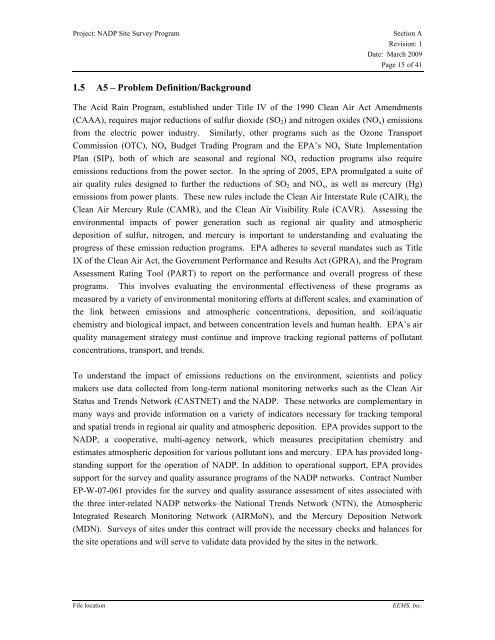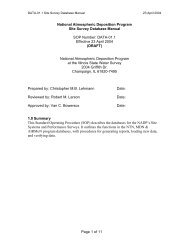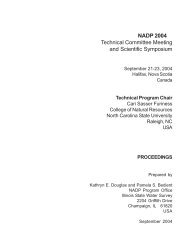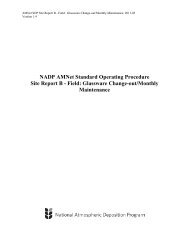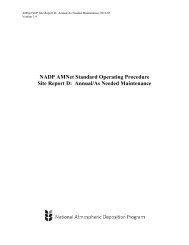- Page 1 and 2: QUALITY ASSURANCE PROJECT PLAN (QAP
- Page 4 and 5: Project: NADP Site Survey Program P
- Page 6 and 7: Project: NADP Site Survey Program P
- Page 8 and 9: Project: NADP Site Survey Program P
- Page 10 and 11: Project: NADP Site Survey Program S
- Page 12 and 13: Project: NADP Site Survey Program S
- Page 16 and 17: Project: NADP Site Survey Program S
- Page 18 and 19: Project: NADP Site Survey Program S
- Page 20 and 21: Project: NADP Site Survey Program S
- Page 22 and 23: Project: NADP Site Survey Program S
- Page 24 and 25: Project: NADP Site Survey Program S
- Page 26 and 27: Project: NADP Site Survey Program S
- Page 28 and 29: Project: NADP Site Survey Program S
- Page 30 and 31: Project: NADP Site Survey Program S
- Page 32 and 33: Project: NADP Site Survey Program S
- Page 34 and 35: Project: NADP Site Survey Program S
- Page 36 and 37: Project: NADP Site Survey Program S
- Page 38 and 39: Project: NADP Site Survey Program S
- Page 40 and 41: Project: NADP Site Survey Program S
- Page 42 and 43: Appendix A. NADP Site Survey Progra
- Page 44 and 45: This page left blank intentionally
- Page 46 and 47: NTN Site Performance Survey SOP Doc
- Page 48 and 49: NTN Site Performance Survey SOP Doc
- Page 50 and 51: NTN Site Performance Survey SOP Doc
- Page 52 and 53: NTN Site Performance Survey SOP Doc
- Page 54 and 55: NTN Site Performance Survey SOP Doc
- Page 56 and 57: NTN Site Performance Survey SOP Doc
- Page 58 and 59: NTN Site Performance Survey SOP Doc
- Page 60 and 61: NTN Site Performance Survey SOP Doc
- Page 62 and 63: NTN Site Performance Survey SOP Doc
- Page 64 and 65:
NTN Site Performance Survey SOP Doc
- Page 66 and 67:
NTN Site Performance Survey SOP Doc
- Page 68 and 69:
NTN Site Performance Survey SOP Doc
- Page 70 and 71:
This page left blank intentionally
- Page 72 and 73:
MDN Site Performance Survey SOP Doc
- Page 74 and 75:
MDN Site Performance Survey SOP Doc
- Page 76 and 77:
MDN Site Performance Survey SOP Doc
- Page 78 and 79:
MDN Site Performance Survey SOP Doc
- Page 80 and 81:
MDN Site Performance Survey SOP Doc
- Page 82 and 83:
MDN Site Performance Survey SOP Doc
- Page 84 and 85:
MDN Site Performance Survey SOP Doc
- Page 86 and 87:
MDN Site Performance Survey SOP Doc
- Page 88 and 89:
MDN Site Performance Survey SOP Doc
- Page 90 and 91:
MDN Site Performance Survey SOP Doc
- Page 92 and 93:
MDN Site Performance Survey SOP Doc
- Page 94 and 95:
MDN Site Performance Survey SOP Doc
- Page 96 and 97:
This page left blank intentionally
- Page 98 and 99:
AIRMoN Site Performance Survey SOP
- Page 100 and 101:
AIRMoN Site Performance Survey SOP
- Page 102 and 103:
AIRMoN Site Performance Survey SOP
- Page 104 and 105:
AIRMoN Site Performance Survey SOP
- Page 106 and 107:
AIRMoN Site Performance Survey SOP
- Page 108 and 109:
AIRMoN Site Performance Survey SOP
- Page 110 and 111:
AIRMoN Site Performance Survey SOP
- Page 112 and 113:
AIRMoN Site Performance Survey SOP
- Page 114 and 115:
AIRMoN Site Performance Survey SOP
- Page 116 and 117:
AIRMoN Site Performance Survey SOP
- Page 118 and 119:
AIRMoN Site Performance Survey SOP
- Page 120 and 121:
AIRMoN Site Performance Survey SOP
- Page 122 and 123:
PO Box 357593 Gainesville, FL 32635
- Page 124 and 125:
Ohaus Balance SOP Document No.: SOP
- Page 126 and 127:
Ohaus Balance SOP Document No.: SOP
- Page 128 and 129:
Ohaus Balance SOP Document No.: SOP
- Page 130 and 131:
Ohaus Balance SOP Document No.: SOP
- Page 132 and 133:
Ohaus Balance SOP Document No.: SOP
- Page 134 and 135:
Ohaus Balance SOP Document No.: SOP
- Page 136 and 137:
Ohaus Balance SOP Document No.: SOP
- Page 138 and 139:
This page left blank intentionally
- Page 140 and 141:
pH meter SOP Document No.: SOP-EPW0
- Page 142 and 143:
pH meter SOP Document No.: SOP-EPW0
- Page 144 and 145:
pH meter SOP Document No.: SOP-EPW0
- Page 146 and 147:
pH meter SOP Document No.: SOP-EPW0
- Page 148 and 149:
pH meter SOP Document No.: SOP-EPW0
- Page 150 and 151:
pH meter SOP Document No.: SOP-EPW0
- Page 152 and 153:
This page left blank intentionally
- Page 154 and 155:
Conductivity Meter SOP Document No.
- Page 156 and 157:
Conductivity Meter SOP Document No.
- Page 158 and 159:
Conductivity Meter SOP Document No.
- Page 160 and 161:
Conductivity Meter SOP Document No.
- Page 162 and 163:
Conductivity Meter SOP Document No.
- Page 164 and 165:
Conductivity Meter SOP Document No.
- Page 166 and 167:
This page left blank intentionally
- Page 168 and 169:
ACM NTN Precipitation Collector SOP
- Page 170 and 171:
ACM NTN Precipitation Collector SOP
- Page 172 and 173:
ACM NTN Precipitation Collector SOP
- Page 174 and 175:
ACM NTN Precipitation Collector SOP
- Page 176 and 177:
ACM NTN Precipitation Collector SOP
- Page 178 and 179:
ACM NTN Precipitation Collector SOP
- Page 180 and 181:
PO Box 357593 Gainesville, FL 32635
- Page 182 and 183:
ACM MDN Precipitation Collector SOP
- Page 184 and 185:
ACM MDN Precipitation Collector SOP
- Page 186 and 187:
ACM MDN Precipitation Collector SOP
- Page 188 and 189:
ACM MDN Precipitation Collector SOP
- Page 190 and 191:
ACM MDN Precipitation Collector SOP
- Page 192 and 193:
ACM MDN Precipitation Collector SOP
- Page 194 and 195:
ACM MDN Precipitation Collector SOP
- Page 196 and 197:
PO Box 357593 Gainesville, FL 32635
- Page 198 and 199:
N-CON MDN Precipitation Collector S
- Page 200 and 201:
N-CON MDNPrecipitation Collector SO
- Page 202 and 203:
N-CON MDNPrecipitation Collector SO
- Page 204 and 205:
N-CON MDNPrecipitation Collector SO
- Page 206 and 207:
N-CON MDNPrecipitation Collector SO
- Page 208 and 209:
N-CON MDNPrecipitation Collector SO
- Page 210 and 211:
PO Box 357593 Gainesville, FL 32635
- Page 212 and 213:
Belfort 5-780 Precipitation Gauge S
- Page 214 and 215:
Belfort 5-780 Precipitation Gauge S
- Page 216 and 217:
Belfort 5-780 Precipitation Gauge S
- Page 218 and 219:
Belfort 5-780 Precipitation Gauge S
- Page 220 and 221:
Belfort 5-780 Precipitation Gauge S
- Page 222 and 223:
Belfort 5-780 Precipitation Gauge S
- Page 224 and 225:
Belfort 5-780 Precipitation Gauge S
- Page 226 and 227:
PO Box 357593 Gainesville, FL 32635
- Page 228 and 229:
OTT NADP Pluvio Electronic Precipit
- Page 230 and 231:
OTT NADP Pluvio Electronic Precipit
- Page 232 and 233:
OTT NADP Pluvio Electronic Precipit
- Page 234 and 235:
OTT NADP Pluvio Electronic Precipit
- Page 236 and 237:
OTT NADP Pluvio Electronic Precipit
- Page 238 and 239:
OTT NADP Pluvio Electronic Precipit
- Page 240 and 241:
OTT NADP Pluvio Electronic Precipit
- Page 242 and 243:
This page left blank intentionally
- Page 244 and 245:
ETI NOAH IV Precipitation Gauge SOP
- Page 246 and 247:
ETI NOAH IV Precipitation Gauge SOP
- Page 248 and 249:
ETI NOAH IV Precipitation Gauge SOP
- Page 250 and 251:
ETI NOAH IV Precipitation Gauge SOP
- Page 252 and 253:
ETI NOAH IV Precipitation Gauge SOP
- Page 254 and 255:
ETI NOAH IV Precipitation Gauge SOP
- Page 256 and 257:
ETI NOAH IV Precipitation Gauge SOP
- Page 258 and 259:
This page left blank intentionally
- Page 260 and 261:
NWS Stick Precipitation Gauge SOP D
- Page 262 and 263:
NWS Stick Precipitation Gauge SOP D
- Page 264 and 265:
NWS Stick Precipitation Gauge SOP D
- Page 266 and 267:
NWS Stick Precipitation Gauge SOP D
- Page 268 and 269:
NWS Stick Precipitation Gauge SOP D
- Page 270 and 271:
NWS Stick Precipitation Gauge SOP D
- Page 272 and 273:
This page left blank intentionally
- Page 274 and 275:
NADP Site Systems Survey SOP Docume
- Page 276 and 277:
NADP Site Systems Survey SOP Docume
- Page 278 and 279:
NADP Site Systems Survey SOP Docume
- Page 280 and 281:
NADP Site Systems Survey SOP Docume
- Page 282 and 283:
NADP Site Systems Survey SOP Docume
- Page 284 and 285:
NADP Site Systems Survey SOP Docume
- Page 286 and 287:
NADP Site Systems Survey SOP Docume
- Page 288 and 289:
NADP Site Systems Survey SOP Docume
- Page 290 and 291:
NADP Site Systems Survey SOP Docume
- Page 292 and 293:
NADP Site Systems Survey SOP Docume
- Page 294 and 295:
NADP Site Systems Survey SOP Docume
- Page 296 and 297:
NADP Site Systems Survey SOP Docume
- Page 298 and 299:
Appendix B. Site Performance Survey
- Page 300 and 301:
2 of 18 25. Other environmental mon
- Page 302 and 303:
4 of 18 Siting Criteria Field Form
- Page 304 and 305:
6 of 18 On File Value Updated Value
- Page 306 and 307:
ACM Collector Field Form Station ID
- Page 308 and 309:
10 of 18 57. Voltage of motorbox at
- Page 310 and 311:
12 of 18 13. Was the 'as found' zer
- Page 312 and 313:
14 of 18 Site Supplies Field Form S
- Page 314 and 315:
16 of 18 Backup Raingage Field Form
- Page 316:
18 of 18 Object Description Azimuth


